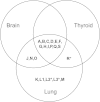Heterogeneous pulmonary phenotypes associated with mutations in the thyroid transcription factor gene NKX2-1
- PMID: 23430038
- PMCID: PMC3760742
- DOI: 10.1378/chest.12-2502
Heterogeneous pulmonary phenotypes associated with mutations in the thyroid transcription factor gene NKX2-1
Abstract
Background: Mutations in the gene encoding thyroid transcription factor, NKX2-1, result in neurologic abnormalities, hypothyroidism, and neonatal respiratory distress syndrome (RDS) that together are known as the brain-thyroid-lung syndrome. To characterize the spectrum of associated pulmonary phenotypes, we identified individuals with mutations in NKX2-1 whose primary manifestation was respiratory disease.
Methods: Retrospective and prospective approaches identified infants and children with unexplained diffuse lung disease for NKX2-1 sequencing. Histopathologic results and electron micrographs were assessed, and immunohistochemical analysis for surfactant-associated proteins was performed in a subset of 10 children for whom lung tissue was available.
Results: We identified 16 individuals with heterozygous missense, nonsense, and frameshift mutations and five individuals with heterozygous, whole-gene deletions of NKX2-1. Neonatal RDS was the presenting pulmonary phenotype in 16 individuals (76%), interstitial lung disease in four (19%), and pulmonary fibrosis in one adult family member. Altogether, 12 individuals (57%) had the full triad of neurologic, thyroid, and respiratory manifestations, but five (24%) had only pulmonary symptoms at the time of presentation. Recurrent respiratory infections were a prominent feature in nine subjects. Lung histopathology demonstrated evidence of disrupted surfactant homeostasis in the majority of cases, and at least five cases had evidence of disrupted lung growth.
Conclusions: Patients with mutations in NKX2-1 may present with pulmonary manifestations in the newborn period or during childhood when thyroid or neurologic abnormalities are not apparent. Surfactant dysfunction and, in more severe cases, disrupted lung development are likely mechanisms for the respiratory disease.
Figures



Comment in
-
Pediatric interstitial lung disease: thyroid transcription factor-1 mutations and their phenotype potpourri.Chest. 2013 Sep;144(3):728-730. doi: 10.1378/chest.13-0550. Chest. 2013. PMID: 24008946 No abstract available.
References
-
- Amin RS, Wert SE, Baughman RP, et al. Surfactant protein deficiency in familial interstitial lung disease. J Pediatr. 2001;139(1):85-92 - PubMed
-
- Shulenin SNL, Nogee LM, Annilo T, Wert SE, Whitsett JA, Dean M. ABCA3 gene mutations in newborns with fatal surfactant deficiency. N Engl J Med. 2004;350(13):1296-1303 - PubMed
-
- Boggaram V. Thyroid transcription factor-1 (TTF-1/Nkx2.1/TITF1) gene regulation in the lung. Clin Sci (Lond). 2009;116(1):27-35 - PubMed
-
- Breedveld GJ, van Dongen JW, Danesino C, et al. Mutations in TITF-1 are associated with benign hereditary chorea. Hum Mol Genet. 2002;11(8):971-979 - PubMed
Publication types
MeSH terms
Substances
Grants and funding
LinkOut - more resources
Full Text Sources
Other Literature Sources
Medical

